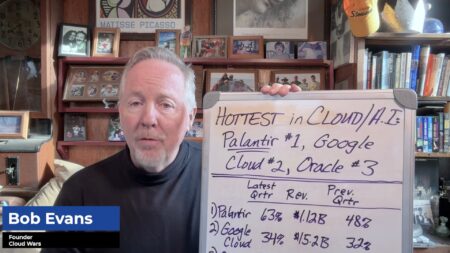Whatever level of commercial success the self-driving Oracle Autonomous Database ultimately achieves, it has surely already become the most highly touted and heavily hyped bet-the-company product ever introduced by Oracle—and perhaps by any tech company.
That’s all fine—it’s part of the high-intensity world we live in here in 2019. Just five months ago Oracle chairman Larry Ellison put it this way: “Sometimes I liken the computer industry to the fashion industry—some brands get very popular, certain brands get very unpopular.”
And in an article I wrote exactly one year ago today, I quoted Ellison as saying that Autonomous Database “is the most important thing the company’s ever done” and that it “will change the profile of our company forever.”
I happen to believe Autonomous Database will be a hugely successful product because, all the frothy hype aside, the performance benchmarks Oracle has produced are striking, the economics are compelling, the cybersecurity implications are strategically essential, and one customer has already reported astounding results.
In my recent article called Oracle’s Larry Ellison Bet the Company On Autonomous Database—And Odds Just Improved, customer TaylorMade Golf shares some of its early and very successful experiences with Autonomous Database. And here’s the money comment from that article:
In a video testimonial for Oracle, TaylorMade VP of IT Tom Collard says that after shifting an entire workload into the Autonomous Data Warehouse, “We’re seeing a 40-times improvement in our reporting workloads with no efforts by our internal DBAs. And that’s been very impressive.”
The customer emphasized that he specifically meant an improvement not of just 40%, but of 40x. As he says, that is indeed “very impressive.”
But in light of how Ellison and Oracle have positioned their self-driving, self-patching database, anything less than “very impressive” will have to be regarded as at least a major disappointment and probably a failure.
So let’s take a look at the latest sky-high expectations from Oracle regarding its Autonomous Database. Because those claims and the surrounding rationale reveal the essence of Oracle’s strategic intentions in a market where, as Ellison admitted in an interview late last year with Maria Bartiromo, “we didn’t get our database to the cloud quickly enough.”
Over the past 18 months, Ellison and Oracle have been relentless in touting the new database as revolutionary. For our purposes today we’ll just look at what Ellison said on Oracle’s earnings call last week. For each anecdote, I’ve highlighted the central advantage Ellison is describing.
Larry Ellison on the Oracle Autonomous Database, March 14, 2019
- “Oracle’s future rests on two strategic businesses, Cloud Applications and Cloud Infrastructure… The introduction of our Gen2 highly secure infrastructure, featuring the Oracle Autonomous Database has been very well received. During Q3, we had nearly 1,000 paying Autonomous Database customers and over 4,000 active trials… The Oracle Autonomous Database is the only database that can respond to a security threat by automatically patching itself, while it’s still running your application. No downtime is required. No other database has this capability.”
- “Some of our customers were stunned that they can get a database up and running in five minutes. So we’ve been collecting references and studying the 1,000 customers and the 4,000 trials and what they find encouraging about the Autonomous Database. Certainly, we’ll call it productivity improvements. The fact that they can go from not having a database, not having hardware, literally log onto our cloud, create an instance, get move their data, and be up and running, and doing useful things in five minutes is proving to be a shock to a lot of our customers.”
- “We’ve got one customer who’s done a series of tests. They were an AWS user, and I know we have these ads that promise cut your AWS bill in half. They found that we were running 11.5 times faster than they were running on AWS and they cut their bill by 80%. These are university researchers. So they’re very, very cost sensitive and they felt it was worthwhile making the move just because we were much less expensive. Autonomous Database was way less expensive than Redshift or Aurora at Amazon.”
- “Some people had an existing data warehouse. And it was just the compatibility, being able to take an existing data warehouse, not spooling up a new one in five minutes, but taking an existing data warehouse, lifting it and shifting it over. So we’re seeing all three of those motivators—productivity, compatibility, and cost— all driving the usage of Autonomous Database.”
- “The researchers that I mentioned earlier that are moving from AWS for big cost savings, they’re doing a combination of machine learning and computer vision to look at tissue samples and detect anomalous cells, using computers to diagnose cancer. And that’s a combination of machine learning and the Autonomous Database, and that’s an all new application. So there are several people that are coming in with all-new applications in the cloud, especially the ones moving from AWS.”
- “There are customers that are moving… test and development into the cloud. Again, the general reaction there is they’re much, much more productive getting running, it’s much cheaper to do test and development, much more responsive, much more productive to move test and development from their on-premise infrastructure to the cloud infrastructure. So online transaction processing, lifting and shifting applications, data warehousing lifting and shifting, test and development, moving from AWS—there are lots of different use cases.”
No doubt, some compelling anecdotes from Ellison about the product that is “the most important thing the company’s ever done.”
But with the business world changing so quickly and customers’ digital-business requirements escalating relentlessly, Oracle has to rapidly shift the narrative around Autonomous Database from its potential and its profile to dazzled and passionate customers telling their stories in public and generating huge volumes of revenue for a company that needs to show that its best days are still ahead of it.
Disclosure: at the time of this writing, Oracle is a client of Evans Strategic Communications LLC.
Subscribe to the Cloud Wars Newsletter for twice-monthly in-depth analysis of the major cloud vendors from the perspective of business customers. It’s free, it’s exclusive, and it’s great!








